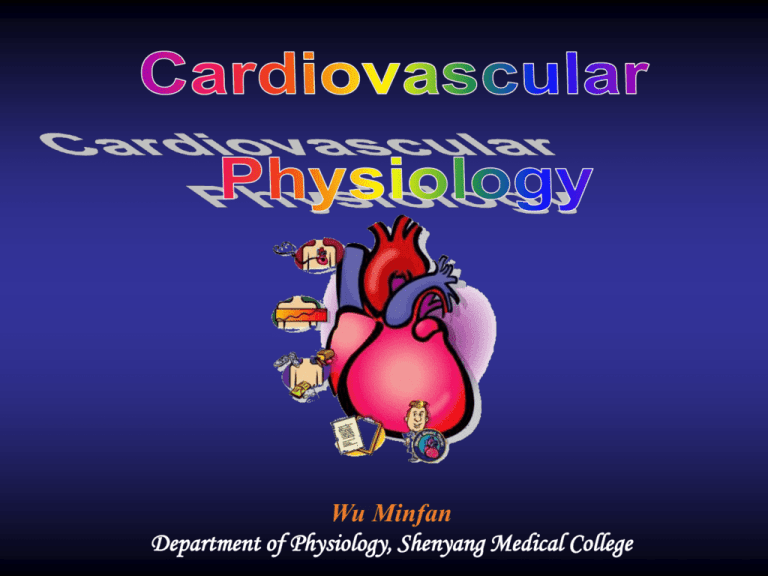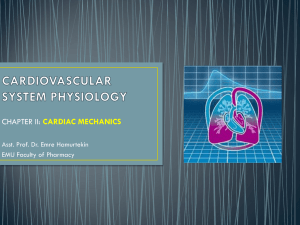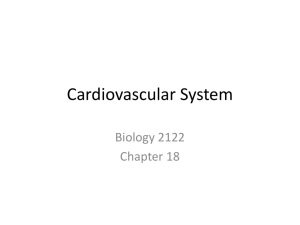(1). heart rate ↑→cardiac output
advertisement

Wu Minfan Department of Physiology, Shenyang Medical College Introduction The cardiovascular system consists of the heart and the blood vessels. The right ventricle pumps blood through the pulmonary circulation to the left atrium. The left ventricle ejects blood through the systemic circulation to the right atrium. (F) The function of blood circulation is to transport substances in human body. Systemic and Pulmonary Circulation 1. Right Heart a. receives venous blood from systemic circulation via superior and inferior vena cava into right atrium. b. pumps blood to pulmonary circulation, and then to left heart. 2. Left Heart – a. receives oxygenated blood from pulmonary circulation via pulmonary vein into left atrium. – b. pumps blood into systemic circulation, and then to right heart. 1. Atrioventricular V a. mitral--between LA and LV; two leaflets b. tricuspid--between RA and RV; three leaflets 2. Semilunar V a. aortic--three leaflets b. pulmonary-three leaflets Heart Valves Function of Heart Valves Prevent backward flow Provide low resistance to forward flow Section one Pump function of the heart The busy and hard working heart! I. Cardiac Cycle 1.Concept: The period of one contraction and one relaxation of the heart. 2.Relationship of the cardiac cycle and Heart rate 60s Cardiac cycle= ———— Heart rate Heart rate:75 beats/min 60s Cardiac cycle = —— =0.8sec 75 A cardiac cycle consists of a systole and a diastole. Atrial cycle equals to ventricular cycle. Diastole is longer than systole. When heartbeat becomes more rapid, the cardiac cycle is shorter, and the diastole is much shorter than normal. Tachycardia is unfavourable for the heart. Whole heart relaxation phase means this period of the first 0.4s of the ventricular relaxation in which atrium is also in relaxation state. 0.7s 0.1s Atrium Ventricle 0.3s Contraction 0.5s Relaxation II. Mechanical events of the cardiac cycle 1. For example: Processess of blood ejection and filling in the left ventricle Ventricular Systole (1)Period of isovolumic contraction 0.05s (2)Period of rapid ejection 0.1s (3)Period of slow ejection 0.15s Ventricular Diastole (4)period of isovolumic relaxation 0.07s (5)Period of rapid filling 0.11s (6)Period of slow filling 0.22s (7)Atrial systole 0.1s Atria S D DD D D D D Ventricles D S S S D D D D .1 .2 .3 .4 .5 .6 .7 .8 2. The Phases of the Cardiac Cycle (1) Period of isovolumic contraction Events: ventricular contraction ventricular pressure rise atrioventricular valve close the ventricular pressure increase sharply Period: 0.05 sec atrioventricular valve close S1- first heart sound Importance: enable the ventricular pressure to rise from 0 to the level of aortic pressure (2) Period of ejection Events: ventricular contraction continuously the ventricular pressure rise above the arterial pressure semilunar valves open blood pours out of the ventricles 1) Rapid ejection period (0.10s, 66% of the total ejected blood volume, stroke volume) 2) Reduced ejection period (0.15s, 34% of the total ejected blood volume , stroke volume) The aortic pressure actually exceeds the ventricular pressure, but momentum keeps the blood moving forward. (3) Period of isovolumic relaxation Events: ventricular muscle relax the ventricular pressure fall lower than the aortic pressure aortic valve close the ventricular pressure fall sharply second heart sound ←closure of aortic and pulmonary semilunar valves at beginning of ventricular diastole S2- Period: 0.06-0.08 s Importance: Enable the ventricular pressure to fall to the level near the atrial pressure (4) Period of filling of the ventricles Events: Ventricular muscle relax continuously the ventricular pressure is equal or lower than the atrial pressure atrioventricular valve open blood accumulated in the atria rushes into the ventricle blood flow quickly from the atrium to the ventricle. 1) Period of rapid filling. (0.11s, amount of filling, 2/3 of total filling blood volume) 2) Period of reduced filling (0.22s, little blood fills into the ventricle) (5) Atrial systole Significance, 25% of total filling blood volume During high output states or in the failing heart, the amount added by atrial contraction may be of major importance in determining the final cardiac output. Correlation of events in the left side of the heart in each cardiac cycle Mitral Closes :>D S2 Atrial Systole Reduced Ventricular Filling Rapid Ventricular Filling Isovolumic Relax. Reduced Ejection Rapid Ejection Isovolumic contract. Atrial Systole :>O Aortic opens Aortic closes Mitral opens S1 Heart sounds Action of the heart produces mechanical vibrations which are audible at the chest wall as the heart sounds. The first heart sound is caused by closure of the atrioventricular valves and so marks the beginning of ventricular systole. The second heart sound is caused by closure of the aortic and pulmonary valves and so marks the beginning of ventricular diastole. The third heart sound is caused by sudden stretch of the ventricular wall and papillary muscle, and sudden deceleration of filling flow at the end of rapid filling period. The fourth heart sound is caused by unusually strong atrial contraction at the end of ventricular diastole. III. Cardiac Output 1.Stroke volume The amount of blood pumped out of each ventricle per beat is called the stroke volume, about 70mL in a resting adult. Stroke volume = end diastolic volume – end systolic volume the normal range is: 2.Ejection fraction stroke volume End diastolic volume 55-65% × 100% = ejection fraction 70×100% —— =56% 125 125 70 55 3.Cardiac output The output of each ventricle per minute is called the cardiac output. Cardiac Output = Stroke Volume× Heart Rate CO=SV×HR =70 × 75 =5250(ml) It varies with sex, age, and exercise 4.Cardiac index There is a correlation between resting cardiac output and body surface area. The cardiac output per square meter of body surface area is known as the cardiac index. It averages 3.2L/ min·m2 5-6L/min 1.6-1.7m2 the normal range is: 3.0 – 3.5 L/min·m2 5.Cardiac work Like any machine, the heart does work in moving the blood through the circulatory system. 5.Cardiac work Stroke work (J)= stroke volume(L) ×gravity of blood (mean arterial pressure-mean left atrial pressure) (mmHg) ×13.6 ×9.807 ×(1/1000) Minute work (J)= stroke work(J) ×Heart rate Minute work of the right heart = 1/6 of minute work of the left heart IV. Factors Affecting Cardiac Output Contractility Preload Heart Rate Stroke Volume Cardiac Output Afterload Definitions • Preload – amount of stretch on the ventricular myocardium prior to contraction – Ventricular end-diastolic volume or pressure • Afterload – the arterial pressure that a ventricle must overcome while it contracts during ejection – impedance to ventricular ejection Definitions • Contractility – myocardium’s intrinsic ability to efficiently contract and empty the ventricle – (independent of preload & afterload) 1. Preload (Initial length in Cardiac muscle ) Define:Regulation of contractility and cardiac Stroke volume output as a result of changes in cardiac muscle fiber initial length is called heterometric autoregulation, or Starling’s law of the heart. Frank-Starling curve Ventricular end-diastolic volume the Frank - Starling mechanism Frank - Starling curve (1914): 1)Normal range of the LVEDP, 5-6 mmHg; Optimal initial preload, 12-15 mmHg ( 2.0 – 2.2 µm ) 2)When the LVEDP is 15-20 mmHg, LV work is maintained at almost the same level. Left ventricle (LV) function curve 3)When the LVEDP > 20 mmHg, LV work does not change or slightly decreases. • Starling Mechanism : The heart can automatically regulate and balance the relation between stroke volume and volume of venous return : Volume of venous return ↑=> the end-diastolic volume ↑ (preload↑)=> ventricular contraction ↑→ stroke volume ↑ Factors determining the preload (LVEDP) 1. Blood volume of venous return. 1) Period of the ventricle diastole (filling) – heart rate 2) Speed of the venous return (difference between the venous pressure and atrial pressure) 3) pericardial fluid 4) ventricular compliance =ΔV/ΔP --denotes the ease or difficulty with which something can be stretched. myocardial fibrosis 2. Ventricular residual blood volume after contraction Importance of the heterometric regulation • In general, heterometric regulation plays only a shorttime role, such as during the body posture change, artery pressure increase, and unbalance between the left and the right ventricular outputs. • In other conditions, such as exercise, cardiac output is mainly regulated by homometric regulation. 2.Afterload(Aortic pressure) Cardiac output 5 3 1 100 200 mmHg Aortic pressure (mmHg) Short time change of the arterial pressure Arterial pressure rises : isovolumetric contraction phase becomes longer period of ejection becomes shorter stroke volume less more blood left in the left ventricle LVEDP increase through heterometric regulation stroke volume return to normal in next beat. Long time high arterial pressure through neural and humoral regulation the stroke volume is maintained at normal level pathogenesis of the cardiovascular system hypertension myocardial hypertrophy heart failure 3.Myocardial Contractility (homometric regulation) the regulation due to changes in contractility independent of initial length. numbers of activated cross bridge Ca2+ concentration ATPase activity 4.Heart rate Heart rate (beat/min) 40 75 120 200 Cardiac cycle (sec) 1.5 0.8 0.5 0.3 Systole (sec) 0.3 0.25 0.16 Cardiac output 40 180 Heart rate (beat/min) Diastole (sec) 0.5 0.25 0.14 (1). heart rate ↑→cardiac output ↑ (40—180beats/min) (2). heart rate > 160—180beats/min heart rate <40beats/min =>cardiac output ↓ V. Cardiac reserve The capacity of the heart to increase cardiac output to satisfy human metabolic needs is called cardiac reserve. The maximal cardiac output subtracts the normal value. It reflects the ability of the heart to adapt the change of environment (internal or external) During muscular exercise, there is increased cardiac output. Myocardial contractility Heart rate Diastolic inflow Stroke volume CO SV HR EDV ESV LVW (L/min) (mL/beat) (beat/min) (mL) (mL) (J/min) Rest 5 Exercise 35 120~140 180~210 Reserve volume 30 60~80 130~140 60~80 70~80 120~160 60~80 60 130~170 10~20 195 10~20 135 40~50 1 Heart rate rises:2-2.5 times 2 Reserve of stroke volume : 200 beats/min 140 ( ml ) 15 End-diastolic volume 15 ml 125 70 55 End-systolic volume 35-40 35-40 ml 15-20







![Cardio Review 4 Quince [CAPT],Joan,Juliet](http://s2.studylib.net/store/data/005719604_1-e21fbd83f7c61c5668353826e4debbb3-300x300.png)